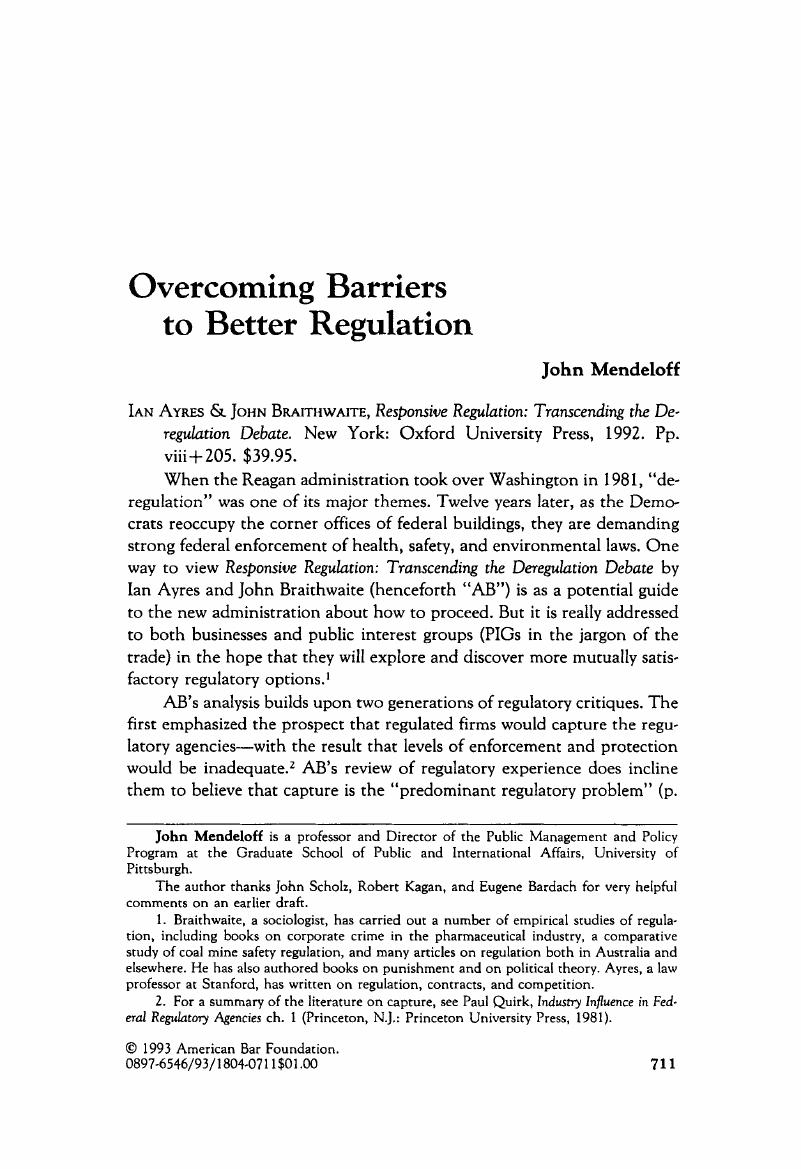Article contents
Overcoming Barriers to Better Regulation
Published online by Cambridge University Press: 27 December 2018
Abstract

- Type
- Review Essay
- Information
- Copyright
- Copyright © American Bar Foundation, 1993
References
1 Braithwaite, a sociologist, has carried out a number of empirical studies of regulation, including books on corporate crime in the pharmaceutical industry, a comparative study of coal mine safety regulation, and many articles on regulation both in Australia and elsewhere. He has also authored books on punishment and on political theory. Ayres, a law professor at Stanford, has written on regulation, contracts, and competition.Google Scholar
2 For a summary of the literature on capture, see Paul Quirk, Industry Influence in Federal Regulatory Agencies ch. 1 (Princeton, N.J.: Princeton University Press, 1981).Google Scholar
3 See especially Eugene Bardach & Robert Kagan, Going fry the Book: The Problem of Regulatory Unreasonableness (Philadelphia: Temple University Press, 1982).Google Scholar
4 For an account of the undeveloped state of our understanding of enforcement issues at the EPA, see Clifford S. Russell, “Enforcement and Monitoring,” in Paul R. Portney, ed., Public Policies for Environmental Protection ch. 10 (Washington, D.C.: Resources for the Future, 1990).Google Scholar
5 Scholz, John T., “Deterrence, Cooperation, and the Ecology of Regulatory Enforcement,” 18 law & Soc'y Rev. 179 (1984).CrossRefGoogle Scholar
6 For other discussions of enforced self-regulation, see Christopher D. Stone, “The Place of Enterprise Liability in the Control of Corporate Conduct,” 90 Yale L.J. 1 (1980); and Bardach & Kagan, Going fry the Book chs. 8 & 9.CrossRefGoogle Scholar
7 AB do raise the point that capture of an agency can, in some circumstances, be efficient because the firm forces the agency to consider the costs it bears, which the agency may have disregarded.Google Scholar
8 For a discussion of the determinants of regulatory style, see Robert A. Kagan, “Editor's Introduction: Understanding Regulatory Enforcement,” 11 Law & Pol'y 89 (1989).CrossRefGoogle Scholar
9 Peter Grabosky & John Braithwaite, Of Manners Gentle: Enforcement Strategies of Australian Business Regulatory Agencies (Melbourne: Oxford University Press, 1986).Google Scholar
10 John T. Scholz, “Cooperative Regulatory Enforcement and the Politics of Administrative Effectiveness,” 82 Am. Pol Sci. Rev. 115 (1991).CrossRefGoogle Scholar
11 John Braithwaite, To Punish or Persuade: Enforcement of Coal Mine Safety (Albany: State University of New York Press, 1985).Google Scholar
12 James McKie, “Regulation and the Free Market: The Problem of Boundaries” 1 Bell J. Econ. & Mgmt. Sci. 9 (1970).CrossRefGoogle Scholar
13 Kagan, Robert, “Adversarial Legalism and American Government,” 10 J. Pol'y Analysis & Mgmt. 393 (1991).Google Scholar
14 On Hawkins, see R. Shep Melnick, Regulation and the Courts: The Case of the Clean Air Act (Washington, D.C.: Brookings Institution, 1983); on Bingham, see John Mendeloff, The Dilemma of Toxic Substance Regulation (Cambridge, Mass.: MIT Press, 1988); and on Claybrook, see John D. Graham, Auto Safety: Assessing America's Performance (Dover, Mass.: Auburn House, 1989) (“Graham, Auto Safety”).Google Scholar
15 Harter, Phillip, “Negotiating Regulations: A Cure for Malaise,” 71 Geo. LJ. 17 (1982).Google Scholar
16 Joseph Rees, Reforming the Workplace: A Study of Self-Regulation in Occupational Safety (Philadelphia: University of Pennsylvania Press, 1988).CrossRefGoogle Scholar
17 The trends and figures presented here are adapted from “Twenty Years of Federal OSHA Enforcement Data,” a report prepared by Frederick B. Siskind of the Office of the Assistant Secretary for Policy, U.S. Department of Labor, Jan. 1993.Google Scholar
The act calls for OSHA to carry out its mission through the promulgation and enforcement of safety and health standards. Four primary categories of inspections have been developed, some mandated by the Act. (1) OSHA must respond to written requests from workers for an inspection (“complaint inspections”). (2) It also must conduct “accident investigations” for fatalities and some other serious injuries. (3) OSHA must sometimes conduct “follow-up inspections” to see if the firm has complied with abatement orders. (4) OSHA can direct its remaining inspection resources pretty much as it wants (“programmed inspections”). In addition, responding to complaints about excess legalism, in the mid-1970s OSHA developed a program for providing consultation to employers who requested it. Finally, OSHA has set up a series of special (and usually temporary) programs to regulate less heavy-handedly at firms that demonstrated stronger commitments to safety.Google Scholar
18 Scholz, John T. & Gray, Wayne B., “OSHA Enforcement and Workplace Injuries: A Behavioral Approach to Risk Assessment,” 3 J. Risk & Uncertainty. 283 (1990).CrossRefGoogle Scholar
19 As described below, the Bureau of Labor Statistics, which relies on voluntary employer reporting for every other data set except the Occupational Safety and Health Survey, fears that reporting might be jeopardized if employers thought that OSHA had access to the establishment-level data. Given the benefits to OSHA if it had access to this data, those fears should probably not carry much weight. In any event, the restrictions on researchers appear totally unjustified.Google Scholar
20 Schoh Si Gray, 3 J. Risk & Uncertainty. Google Scholar
21 For an account of this period, see George C. Eads & Michael Fix, Relief or Reform: Reagan's Regulatory Dilemma (Washington, D.C.: Urban Institute, 1984).Google Scholar
22 Motor Vehicle Mfrs' Ass'n v. State Farm Mut. Ins. Co., 463 U.S. 29 (1983).Google Scholar
23 Chevron U.S.A. v. Nat'l Resource Defence Council, 104 S. Ct. 2778 (1984).Google Scholar
24 Patricia Wald, “The Realpolitik of Judicial Review in a Deregulation Era,” 5 J. Policy Analysis & Mgmt. 535 (1986).CrossRefGoogle Scholar
25 John Mendeloff, “On the Feasibility of Strict and Extensive Rulemaking,” 16 J. Health Pol, Pol'y, & L. 19 (1991).CrossRefGoogle Scholar
26 Graham, Auto Safety (cited in note 14).Google Scholar
- 5
- Cited by




